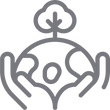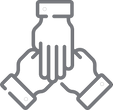Ayo Oslo set out to create woollen garments that would step forward from the status quo challenges in the world of woollens. The result is an intricate value chain where many parameters have been taken into consideration. Read more about the Ayo Oslo Improved Wool Initiative™ and why we are unique.
ENVIRONMENT


Top image: degraded pasture area. Bottom image: rehabilitated pasture area Mongolia.
GARMENT AND PROCESSING
Much water and energy go into the processing of garments. Omitting attribute-enhancing processes in the production stages has reduced the eco-footprint of our products in that there is 90% less water-, 28% less energy consumption and 86% less CO2 emissions compared to other commercial woollen garments on the market, leaving ours naturally soft, and ready to be enjoyed by even the most exacting customer. Once the garment has lived its full cycle; worn year after year, repaired, handed down as an heirloom and donated to thrift shops, it will eventually unite with Mother Nature due to being biodegradable.
TRANSPORTATION
A big part of our value chain is carried out in Mongolia, therefore unnecessary emissions due to transportation are reduced. Transportation of the goods from Mongolia will be handled by our logistics partner DHL, a company dedicated to offering green logistic solutions. Find out more on their website. Our local logistics partner in Norway will be Posten/Bring - a partner also dedicated to reducing their carbon footprint, aiming to reduce it significantly by 40% by 2020.
ANIMAL WELFARE = SUPERIOR RAW MATERIAL
Animal welfare is important for Mongolian herders. The herders depend on their livestock for food security and income, thus treating their livestock with respect is a part of the nomadic herders' lifestyle, as carried out for generations.
Wool from Mongolia is considered to be amongst the highest quality wool in the world. The animals are able to yield superior quality wool fibres because of the harsh winter temperatures, at times -40 degrees. The animals graze in the vast steppes of Mongolia and are free from mulesing practices. The wool is hand-combed by the herders. Combing excess fleece off the animals will not only financially secure the herders, but the animals will also be more comfortable during the hot summers in Mongolia.
SOCIAL RESPONSIBILITY
We source our wool from the Nomadic herders of Mongolia. They live a traditional lifestyle, where respect and harmony prevail between humans and their livestock. Buying wool from them enable the communities to be self-sufficient and help them thrive.
We knit our sweaters in Mongolia, where the raw material is from, ensuring most of the value chain remains in Mongolia, which in turn will benefit the local communities.
















